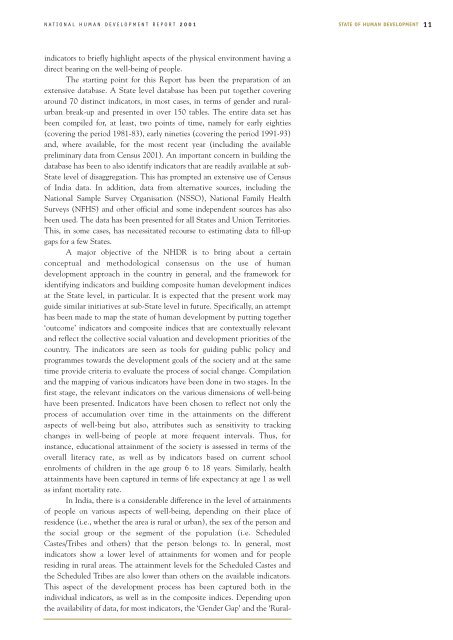National Human Development Report: 2001 - Indira Gandhi Institute ...
National Human Development Report: 2001 - Indira Gandhi Institute ...
National Human Development Report: 2001 - Indira Gandhi Institute ...
- No tags were found...
Create successful ePaper yourself
Turn your PDF publications into a flip-book with our unique Google optimized e-Paper software.
NATIONAL HUMAN DEVELOPMENT REPORT <strong>2001</strong> STATE OF HUMAN DEVELOPMENT 11indicators to briefly highlight aspects of the physical environment having adirect bearing on the well-being of people.The starting point for this <strong>Report</strong> has been the preparation of anextensive database. A State level database has been put together coveringaround 70 distinct indicators, in most cases, in terms of gender and ruralurbanbreak-up and presented in over 150 tables. The entire data set hasbeen compiled for, at least, two points of time, namely for early eighties(covering the period 1981-83), early nineties (covering the period 1991-93)and, where available, for the most recent year (including the availablepreliminary data from Census <strong>2001</strong>). An important concern in building thedatabase has been to also identify indicators that are readily available at sub-State level of disaggregation. This has prompted an extensive use of Censusof India data. In addition, data from alternative sources, including the<strong>National</strong> Sample Survey Organisation (NSSO), <strong>National</strong> Family HealthSurveys (NFHS) and other official and some independent sources has alsobeen used. The data has been presented for all States and Union Territories.This, in some cases, has necessitated recourse to estimating data to fill-upgaps for a few States.A major objective of the NHDR is to bring about a certainconceptual and methodological consensus on the use of humandevelopment approach in the country in general, and the framework foridentifying indicators and building composite human development indicesat the State level, in particular. It is expected that the present work mayguide similar initiatives at sub-State level in future. Specifically, an attempthas been made to map the state of human development by putting together‘outcome’ indicators and composite indices that are contextually relevantand reflect the collective social valuation and development priorities of thecountry. The indicators are seen as tools for guiding public policy andprogrammes towards the development goals of the society and at the sametime provide criteria to evaluate the process of social change. Compilationand the mapping of various indicators have been done in two stages. In thefirst stage, the relevant indicators on the various dimensions of well-beinghave been presented. Indicators have been chosen to reflect not only theprocess of accumulation over time in the attainments on the differentaspects of well-being but also, attributes such as sensitivity to trackingchanges in well-being of people at more frequent intervals. Thus, forinstance, educational attainment of the society is assessed in terms of theoverall literacy rate, as well as by indicators based on current schoolenrolments of children in the age group 6 to 18 years. Similarly, healthattainments have been captured in terms of life expectancy at age 1 as wellas infant mortality rate.In India, there is a considerable difference in the level of attainmentsof people on various aspects of well-being, depending on their place ofresidence (i.e., whether the area is rural or urban), the sex of the person andthe social group or the segment of the population (i.e. ScheduledCastes/Tribes and others) that the person belongs to. In general, mostindicators show a lower level of attainments for women and for peopleresiding in rural areas. The attainment levels for the Scheduled Castes andthe Scheduled Tribes are also lower than others on the available indicators.This aspect of the development process has been captured both in theindividual indicators, as well as in the composite indices. Depending uponthe availability of data, for most indicators, the ‘Gender Gap’ and the ‘Rural-

















